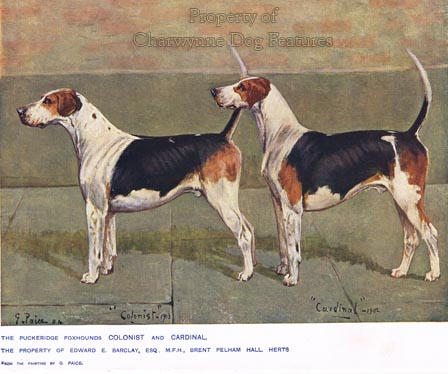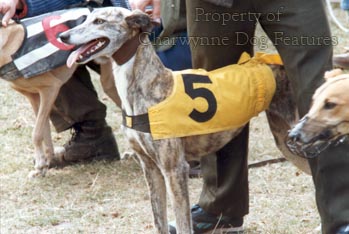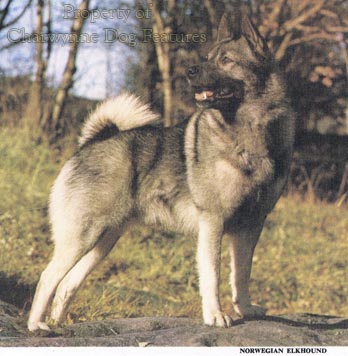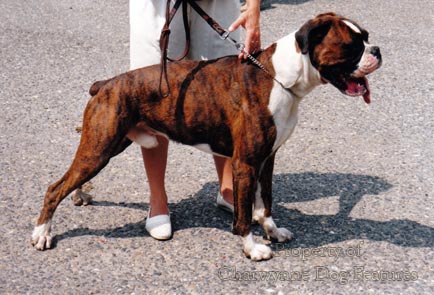609 Taxing Inheritance
INHERITANCE IS TAXING
by David Hancock
 Some breeds have never produced an outstanding breeder. Far too few experienced breeders offer advice in depth to newcomers. I have never been to a breed seminar in which a highly successful breeder has been willing to address the audience on the subject of "My Breeding Method". Advice, good and bad, on how to rear puppies or assist in their whelping is often forthcoming, but rarely informed advice on how to best beget quality pups. Yet away from the show ring, Foxhound breeders have always striven to produce a better hound, by themselves or through other kennels. They have been discussing breeding systems for two centuries, without apparent signs of petty jealousy.
Some breeds have never produced an outstanding breeder. Far too few experienced breeders offer advice in depth to newcomers. I have never been to a breed seminar in which a highly successful breeder has been willing to address the audience on the subject of "My Breeding Method". Advice, good and bad, on how to rear puppies or assist in their whelping is often forthcoming, but rarely informed advice on how to best beget quality pups. Yet away from the show ring, Foxhound breeders have always striven to produce a better hound, by themselves or through other kennels. They have been discussing breeding systems for two centuries, without apparent signs of petty jealousy.
Inheritance, whether it leads to successful Foxhounds, faster Greyhounds, softer-mouthed gundogs, more efficient tracking Bloodhounds or just good-tempered healthy family pets, is not accidental. Empirical evidence is often available. We can learn, for example, that a fawn to fawn mating in Boxers and Great Danes has produced a brindle but it is extremely rare in Bullmastiffs. We know that the brindle factor is handed on very similarly in Whippets, Greyhounds and Great Danes, that Otterhound coat colours are analogous with those of the Bloodhound and that sighthounds are often black or blue but scenthounds relatively rarely. 
We are informed that breeds like the Airedale Terrier, the Collie varieties, the Setter family, the Elkhound and the Cocker Spaniel are mute on the trail, but that the Bloodhound, the Foxhound, the Beagle, the Dachshund and Sussex Spaniel are 'open' trailers, that is they give tongue on the trail. The 'treeing' aptitude, the head held high for air scent or low for ground scent, the tendency to mouth prey rather than kill it quickly and the impulse to 'hold' or 'pin' rather than 'slash' at a running quarry, are all inherited as distinctly as more visible characteristics.
Geneticists also tell us that the brindle factor is a limit to a black coat which only manifests itself in black cross stripes and a black mask extending to a black muzzle. The mask factor is a limit to a black coat so that only the mask and muzzle can be black, the remainder of the dog is red or fawn or shades of these. Short hair is genetically dominant over long hair and there are genes which modify leg length, with short crooked legs incompletely dominant over normal straight legs.
There is a certain relation between the dog's coat and its eye and nose colour. The colour of the tip of the nose closely agrees with the colour of the lips and the balls of the feet. Hanging ears are dominant over upright ears, yet semi-erect ears are dominant over upright ears. A sharp nose is dominant over a blunt nose. the overshot jaw is more likely to be inherited than the undershot one. The short tail is dominant over the long tail. The desire to enter water. strong in the Newfoundland, weak in the Bullmastiff and Bloodhound, is a dominant factor. Many different genes are responsible for ear and tail position.
Variation within the brindle and fawn patterns of coat applies similarly to Boxers and Bullmastiffs, with indications that the black mask and muzzle is dominant over no black mask and muzzle. Brindle to brindle matings in Boxers and Great Danes produce more than five times as many brindle pups as fawns. But just as there are known characteristics of colour inheritance so too are there of temperament and learning ability. No amount of training can make a mentally sluggish dog into a mentally alert, eager to learn dog. Excitable, excessively nervous, highly strung dogs or dogs with untrustworthy tempers are exhibiting inherited characteristics and should not always be bred from.
The facts or tendencies or breed predispositions advised to us by geneticists are of value to breeders when planning specific breeding programmes using named dogs. Such genetic facts however have limited value unless they can be linked to schemes covering the genetic health of a breed, the verified accuracy of written pedigrees, the unambiguous identification of individual dogs and recorded family histories, showing strong points and weaker ones in the line. By appointing a geneticist for each breed, supported by a breed archivist, and by initiating a breed survey, the likelihood of obtaining improved quality in a breed can be enhanced. Trained qualified judges are more likely too to reward the best dogs and identify the best breeding material than those offered such an appointment because of their length of service, frequency of judging or past record as a prolific breeder.
mall breeders need to have more knowledge than those who in past times could support a kennel housing hundreds of dogs. The quality of pedigree dog seen in so many breeds in far too many show rings reflects the amateur ill-informed manner in which all too many breeders approach their hobby. If you do go ahead and mate your 'pet-quality' bitch with the best in show at Crufts of your breed then don't be surprised if you get indifferent stock, which resemble the poor quality of their grandparents. You will be getting what you deserve and it will be an expensive lesson. But you will not be the first or last to try such a slipshod method. Sadly, genetics is not the science of optimism! As we proceed into the new millennium, a genuinely scientific basis for dog breeding is screamed out for. Only then will the 21st century British dog be, as Shakespeare put it in Richard II, "Fear'd by their breed and famous by their birth."